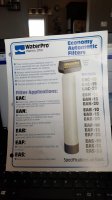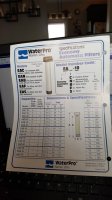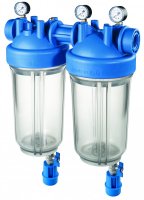Djd5059
New Member
We built a house last year, moved in at the end of August. Our well is 260 feet deep with 60 feet of casing, 30gpm when it was drilled. We run a water softener. Others in our neighborhood have had issues with their water (bacteria, solids, etc.) and have installed whole house filters. It's a widely-spaced neighborhood. Most lots are around 1.5 acres.
Over the weekend, coinciding with a spike in temperatures in February into the 60s, we started seeing some cloudy water. We first noticed this in toilets with some brown sediment settling in the tank and cloudy water in the bowl. It seemed like we went to bed on Saturday with clear water and woke up on Sunday with cloudy water, but we get our drinking water from bottles and/or the fridge filter, so it's likely it was more of a gradual change and we just didn't notice.
I called the company that drilled the well on Monday after talking to our builder over the weekend. The well guy said it was common to get a "shot" of sediment after a thaw but that if the problem persisted, they could come out and clean the well if we wanted.
The father of one of our neighbors installs whole house filtration systems. He's coming over on Monday to test the water (bacteria, solids, the works) and make recommendations.
I'm trying to do some research in advance of the tests and possibly getting into it with the company that drilled the well. I grew up on city water. My wife grew up on well water, but we grew up near Lake Erie, meaning her well was only 50 feet deep or so and was already 25 years old before she was born and never had issues with sediment or bacteria as far as her father can remember. In other words, this is a new situation for both of us, and we want to avoid silly missteps/getting talked into spending a ton of money when it isn't really necessary.
Here are a few lead-off questions:
1. The well is only 6 months old, and it pulled clear water for the first 6 months. 60 feet of casing is well below the frost line, so is "it's common to get a shot of sediment after a thaw" a sensible answer? It doesn't make a lot of sense to us, but I know a lot less about wells than the guy who works for the well company.
2. What might the well company do to "clean" it? How to you clean a 260-foot hole in the ground, 200 feet of which doesn't have a casing around it? Is there anything to be gained from cleaning the well, especially if we are seeing issues so soon? Would it just be a temporary solution, or is there some long-term benefit to cleaning it after an initial break-in period? Should we be demanding that the company fix this and fix it for free because the problem is arising so soon, or is this a situation where there are no guarantees for quality because there are too many variables when you drill a hole that deep?
3. Researching whole house water filters is making my head spin. Systems range from $100 to $5,000, and DIYers seem to have systems with a dozen different components, all of which, they claim, are completely necessary and you would be dumb to leave out. Is there a simple solution? Should I just go with what the guy says on Monday if he appears to know what he is talking about and the price is where we want it?
Thanks in advance for any help/advice anyone can offer!
Over the weekend, coinciding with a spike in temperatures in February into the 60s, we started seeing some cloudy water. We first noticed this in toilets with some brown sediment settling in the tank and cloudy water in the bowl. It seemed like we went to bed on Saturday with clear water and woke up on Sunday with cloudy water, but we get our drinking water from bottles and/or the fridge filter, so it's likely it was more of a gradual change and we just didn't notice.
I called the company that drilled the well on Monday after talking to our builder over the weekend. The well guy said it was common to get a "shot" of sediment after a thaw but that if the problem persisted, they could come out and clean the well if we wanted.
The father of one of our neighbors installs whole house filtration systems. He's coming over on Monday to test the water (bacteria, solids, the works) and make recommendations.
I'm trying to do some research in advance of the tests and possibly getting into it with the company that drilled the well. I grew up on city water. My wife grew up on well water, but we grew up near Lake Erie, meaning her well was only 50 feet deep or so and was already 25 years old before she was born and never had issues with sediment or bacteria as far as her father can remember. In other words, this is a new situation for both of us, and we want to avoid silly missteps/getting talked into spending a ton of money when it isn't really necessary.
Here are a few lead-off questions:
1. The well is only 6 months old, and it pulled clear water for the first 6 months. 60 feet of casing is well below the frost line, so is "it's common to get a shot of sediment after a thaw" a sensible answer? It doesn't make a lot of sense to us, but I know a lot less about wells than the guy who works for the well company.
2. What might the well company do to "clean" it? How to you clean a 260-foot hole in the ground, 200 feet of which doesn't have a casing around it? Is there anything to be gained from cleaning the well, especially if we are seeing issues so soon? Would it just be a temporary solution, or is there some long-term benefit to cleaning it after an initial break-in period? Should we be demanding that the company fix this and fix it for free because the problem is arising so soon, or is this a situation where there are no guarantees for quality because there are too many variables when you drill a hole that deep?
3. Researching whole house water filters is making my head spin. Systems range from $100 to $5,000, and DIYers seem to have systems with a dozen different components, all of which, they claim, are completely necessary and you would be dumb to leave out. Is there a simple solution? Should I just go with what the guy says on Monday if he appears to know what he is talking about and the price is where we want it?
Thanks in advance for any help/advice anyone can offer!



